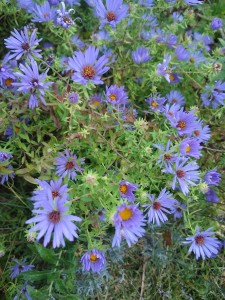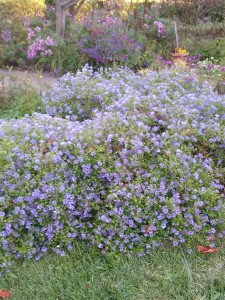 When I look out at the sea of asters in my front yard, it is hard to believe that there was a time when I had none. In search of some fall color, I planted one small pot of tall, pink-flowered ‘Alma Potschke’ asters. ‘Alma’ prospered—so much so that now, if I didn’t pull out the seedlings every year, I would have hundreds of ‘Alma Potschke’ offspring. As it is, there are scores of them, and I truly believe that the seedlings have a 110 percent germination rate.
When I look out at the sea of asters in my front yard, it is hard to believe that there was a time when I had none. In search of some fall color, I planted one small pot of tall, pink-flowered ‘Alma Potschke’ asters. ‘Alma’ prospered—so much so that now, if I didn’t pull out the seedlings every year, I would have hundreds of ‘Alma Potschke’ offspring. As it is, there are scores of them, and I truly believe that the seedlings have a 110 percent germination rate.
Even my nemeses, the hordes of deer that meander through the yard, don’t make a dent in the population. They find asters delicious and snack on the young plants regularly during the summer months. When the deer do this to the lilies, I have to wait until the following year to see any blooms. Not so with asters. Each and every deer-besieged ‘Alma’ responds by branching out and producing more flowers, which ultimately produce more seeds, which in turn germinate and become next year’s seedlings. It’s a “circle of life” phenomenon and the circle keeps expanding.
As the result, my yard fills with many different shades of pink and pink/purple asters in fall. A few years ago I decided that I wanted a bit of blue to complement all the pink offered up by ‘Alma’s offspring. I went out and purchased one of the most popular blue-flowered asters, ‘Monch’, a hybrid of Frikart’s aster, or, more properly, Aster x frikartii ‘Monch’
‘Monch’ grows to about two feet tall, with gently arching stems and medium green oblong leaves. My original plant is now at least 3 feet across and covered with hundreds of the characteristic two-inch, daisy-like flowers in an appealing shade of sky blue. Vigor is one of ‘Monch’s strong suits, and mine is exceptionally vigorous, blooming for about a month in September and October. Several years ago I took a piece of it and planted it in my lower back
garden. The ‘Monch’ division experienced about five seconds of transplant shock and then produced a profusion of blooms. Now it is close to matching the cloud-like appearance of its parent. Next year I will probably divide both the parent and the offspring plants. I may have to open the horticultural equivalent of a lemonade stand to distribute my surplus ‘Monch’ divisions.
‘Monch’ is quite youthful looking for a variety that is over one hundred years old. Introduced in 1918 by Swiss nurseryman and plant breeder Karl Ludwig Frikart, it was named for a mountain in the Alps. English garden writer Val Bourne described ‘Monch’ as “the longest flowering aster [ever] bred.”
Frikart was aiming for asters that were drought tolerant as well as beautiful. To achieve that goal, he crossed two tolerant species, both native to mountainous regions. One was the blue-flowered Italian aster or Aster amellus, native to central and southeastern Europe; the other a pink-flowered Himalayan species, Thompson’s aster, or Aster thompsonii. The crosses produced four offspring that Frikart thought good enough to market. The varieties were ‘Monch,’ ‘Wonder of Staffa,’ ‘Eiger’ and ‘Jungfrau.’ ‘Wonder of Staffa’ is very similar to ‘Monch’ in flower color and configuration. My trusty 1947 edition of the Wayside Gardens catalog offers it and it is still with us. ‘Jungfrau’ is more compact and probably better suited to smaller gardens or even container culture. ‘Eiger’ is probably much like its siblings, but it seems to have almost disappeared from commerce.
Few breeders have crossed the two parent species since, but ‘Monch’ and its siblings acquired a lovely half sister in 1964 when English breeder Alan Bloom crossed varieties of the Thompson’s and Italian asters to produce the pinkish-purple ‘Flora’s Delight.’
In the history of horticulture, one hundred years is not much, but in the history of commercial horticulture—especially in our current amped-up, social media-driven environment where fads succeed each other with lightening speed–one hundred years is an eternity. ‘Monch’ stays current by virtue of being both gorgeous and tough.
My ‘Monch’ has thrived in heavy clay soil, albeit amended with organic material. The Frikart’s asters in general prefer soil that is better drained and closer to the mountain environments favored by their parent species. If you are planting in areas with heavy clay, mix lots of compost, grit or sand with the loose soil at the bottom of the planting hole. Situate the plants in a sunny location and they will do the rest. It’s best to plant and divide in spring, though if someone offers you a ‘Monch’ or ‘Wonder of Staffa’ division in the next two weeks, take it and install it promptly. You will have plenty of blooms next fall.
Some local nurseries may offer end-of-season bargains on Frikart’s asters. If not, order ‘Monch’ and the prolific ‘Alma Potschke’ for spring delivery from Bluestone Perennials, 7211 Middle Ridge Rd, Madison, OH 44057, (800) 852-5243, www.bluestoneperennials.com. Free print catalog. 
